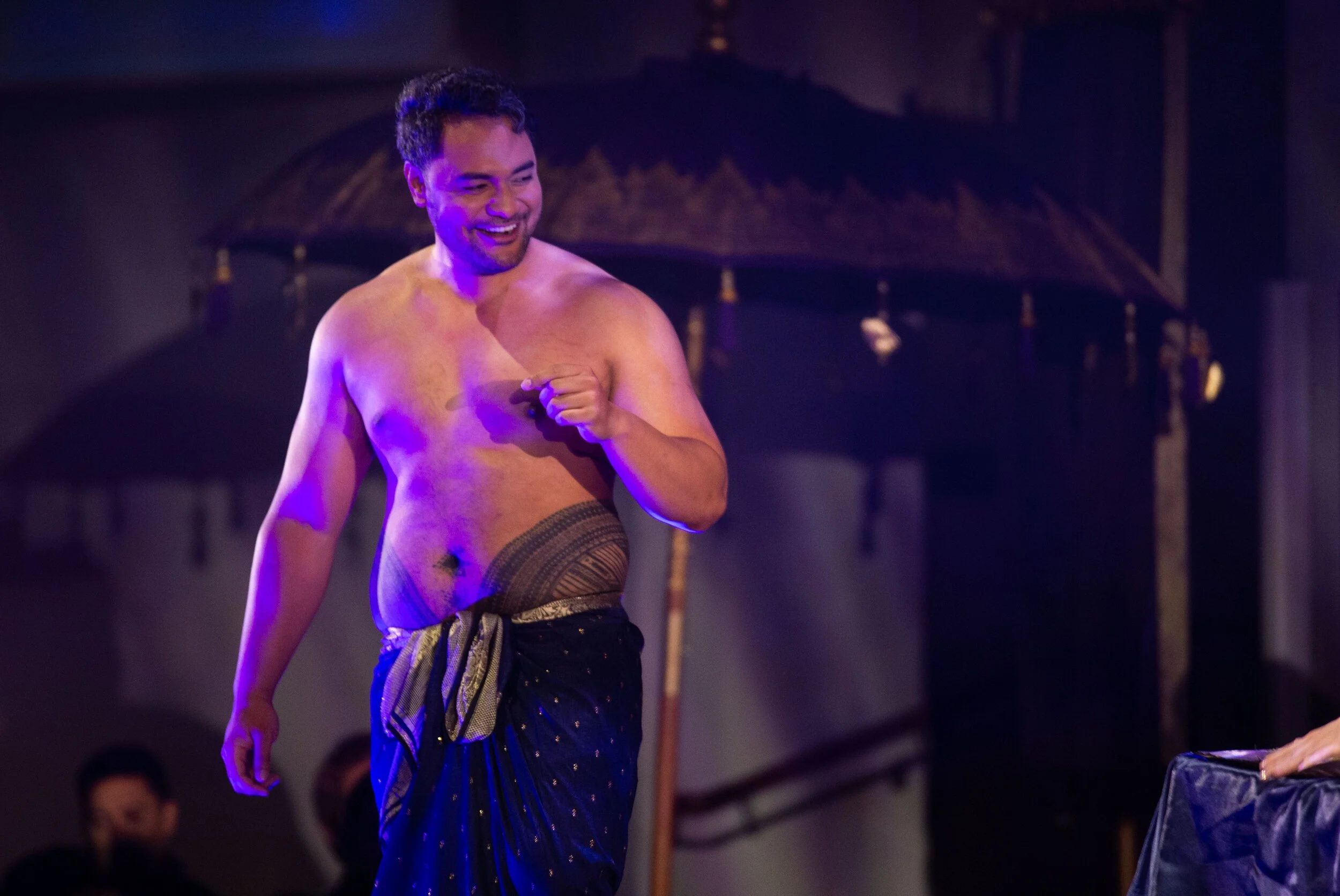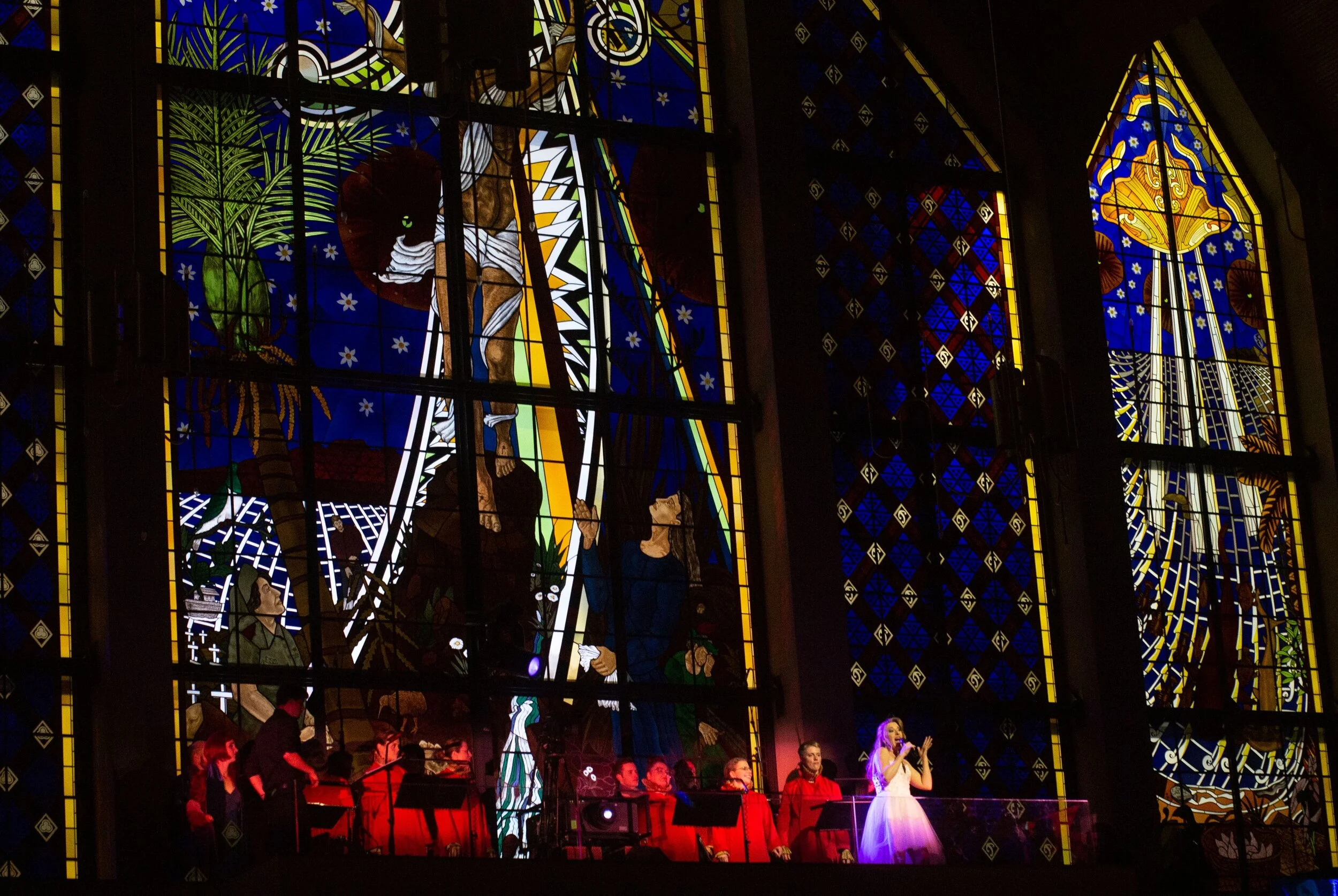New Zealand Opera’s Semele – a sumptuous operatic feast
Soprano Emma Pearson as Semele - “breath-taking”.
Photo credit: Garry Brandon
Thunder roars at the door of the cathedral, interrupting the nuptial ceremony. But is it the weather that’s echoed by timpani behind the altar? No, it’s a large noisy motorbike, with flashing purple lights, and a leather-clad rider who is now swaggering down the wide aisle, helmet dangling from his fingers. And the bride is abandoning her veil, flinging this symbol of her purity down on the sanctuary steps as she turns from her groom and wedding party and runs off with the handsome stranger.
Just a short time earlier we were welcomed as wedding guests from the late afternoon sun of rain-washed Auckland into Holy Trinity Cathedral for the final night of New Zealand Opera’s production of Handel’s Semele. There was a huge buzz of anticipation in the sold-out audience as we took our seats among the flowery bollards of the church. The word was out that this was without doubt one of the most inventive and dazzling productions from the company in recent history.
Locating this secular story within the Cathedral architecture was just one of the surprising, courageous and inspired decisions that enabled Directors Thomas de Mallet Burgess and Jacqueline Coats to turn a work intended for presentation “in the manner of an oratorio” into a sumptuous operatic and visual feast. Their Semele, with stunning design by Tracy Grant Lord and clever lighting by Jo Kilgour, was a marvel of dramatic tension, extravagant debauchery, gauche contemporary comedy and tender pathos.
In spite of the international border challenges of 2020, the casting of Semele was exceptionally apt. Handel’s score makes huge demands of the six principal singers – his arias and recitatives are long with unforgiving technical demands - and yet all combined outstanding singing with surprising complexity of character. Soprano Emma Pearson’s performance in the title role of Semele was breath-taking; her beautiful voice shone with apparent ease in even the most extended coloratura moments. She brought an astonishingly wide range of emotion to the role, at first passionate, seductive, strong and demanding, then petulant, contrite and eventually full of anguish as she realised the fatal consequences of her ambition.
Semele is a tale setting mortal frailty against the power of the gods. The heroine has lost her heart to Jupiter, played by tenor Amitai Pati with warmth and authority. This week Pati was announced inaugural winner of the Dame Malvina Major Award - his glorious voice is well-known to New Zealanders and has brought him international acclaim. Surprisingly this was his debut not only in this role but with NZ Opera itself. Stripped to the hips, revealing the magnificent traditional Samoan tatau, the pe’a, he acquired earlier this year, Pati was god-like in Act 2’s sensual love scene with Semele. His beautiful and compassionate singing of the famous aria “Wheree’er you walk” held the audience spellbound.
Tenor Amitai Pati as Jupiter - “god-like”.
Photo credit: Garry Brandon
Two experienced New Zealand singers returned home from COVID disruptions overseas to sing mixed mortal and supernatural roles in Semele. Mezzo soprano Sarah Castle, well-established in her UK singing career, brought lovely vocal warmth and dramatic panache to the roles of Juno, Jupiter’s wife, and Ino, Semele’s sister. Her poignant ‘You’ve undone me’ was an early highlight. Bass-baritone Paul Whelan works from Manhattan and his splendid deep tones and dignified acting as Cadmus, father of the bride, became even more powerfully compelling as the menacing Somnus, god of sleep.
Jilted bridegroom Athamas is a counter-tenor role, perfect for South African-born New Zealand singer Stephen Diaz. His strong resonant singing in Act 1 occasionally revealed some vocal strain, but his joyous final aria ‘Despair no more shall wound me’ was a brilliant expressive display. Juno’s messenger Iris is played by another young ex-patriate New Zealander, soprano Chelsea Dolman, a splendid foil for the comedy and flair of Castle’s jealous goddess.
Musically Semele was all stylish delight under the experienced baton of Baroque specialist Peter Walls. Handel’s music is full of dramatic invention, evoking terrors with dark and dangerous sliding harmonies and contrasting joys with energy and pace. The small orchestra of Baroque musicians led by concertmaster Peter Clark was located behind the altar and, although I occasionally wished they were positioned forward to shine even more, the production was hugely enhanced by their sensitive yet passionate accompaniment and unfailing support of the singers. The continuo playing of Douglas Mews on keyboards and cellist James Bush was unobtrusively outstanding.
The action was often driven by the versatility and dramatic musicality of the Freemasons New Zealand Opera Chorus. Whether crass wedding guests or shadowy rough sleepers in Somnus’ den, while racing down the aisle in exuberant glee or lolling as debauched partygoers on their cellphones, these fine singers were high energy, characterful and a vocal and musical credit to chorusmaster Andrew Crooks. My highlight of many memorable chorus scenes was their gospel choir-like backing of Semele’s ‘karaoke’ aria “Endless pleasure” from the rear balcony.
Emma Pearson as Semele with the New Zealand Opera Chorus
Photo credit: Garry Brandon
Of course, her pleasure is not endless and Jupiter’s power is ultimate. In most operas the heroine has to die in the end, and Semele is no exception. But although the work disposes of Semele, marries her besotted sister to the groom she spurned and ends with Bacchanalian happiness and glasses of bubbly all round, it’s impossible to forget the compelling performance by Emma Pearson. Let’s rejoice that this brilliant Australian soprano lives in New Zealand this year of all years.
And finally, I’ll give thanks for Handel’s wonderful music - and that New Zealand Opera chose to stage his little known opera, took numerous artistic and other risks, held its nerve in the face of 2020 challenges and brought us this sparkling production. Can they be persuaded to bring it further south?
Handel’s Semele New Zealand Opera at Holy Trinity Cathedral, Auckland October/November 2020



